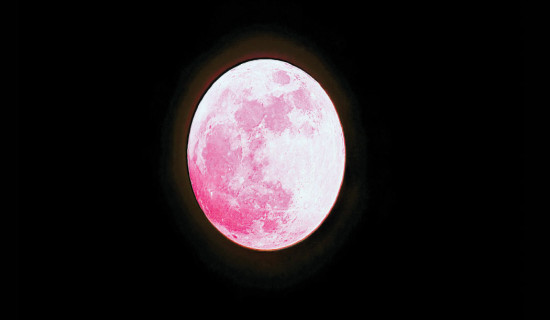- Friday, 6 June 2025
Mesmerising Marvels Of Mars And Venus
The dark night skies of this month would manifest the mesmerizing marvels of planets Mars and Venus along with the spectacular sights of celestial objects spotted all over the heavens. Planet Mercury could be discerned in the western sky after sundown. It would be rushing through constellation Pisces (fishes) towards cute constellation Aries (ram). Chasing it after middle of the month would be difficult. On 11 April the planet Mercury would come to its greatest eastern elongation from the Sun.
It would be the best time to view Mercury since it will be at its highest point above the horizon in the evening sky. Planet Venus could be perceived in western sky after twilight for few hours in the night. It would be gliding through the comely constellation Aries towards constellation Taurus (bull) and then be sinking towards the horizon. Alluring star Aldebaran (Rohini) would be blazing below Venus.
It would be sheer 65 light-years away. Planet Mars would be noticeable after sunset in western sky. It would be cavorting with the stars of zodiacal constellation Gemini (twins) as it would be marching towards the western horizon late in the night.
The confounding stars Castor (Kasturi) and Pollux (Punerbasu) would be coruscating charmingly above Mars. Enigmatically cryptic Castor has been sextuple star system organized in three binary stars and would be curiously 51 light-years away. Orange-hued giant star Pollux would be basically 34 light-years away. Mars would be passing by mysterious star Metsuba meaning roughly outstretched paws of lion in Arabic, during mid-month. Metsuba would be mystically 840 light-years away.
Mighty Planet
Mighty planet Jupiter would stay obscured this month. It would be sailing mostly through constellation Pisces during daytime It would be standing to the east of Mercury. Ringed planet Saturn would be observable tersely in eastern sky before sunrise in the constellation Aquarius (water bearer) and fade away by daybreak. Far-flung planet Uranus would be lost in solar glare and be unseen this month. It would be sliding through constellation Aries below Venus. Similarly bluish planet Neptune would not be easily seen due to its tight tryst with the Sun. It would be creeping in southern section of constellation Pisces.
On 20 April dwarf planet 136108 Haumea would be at opposition, when it would lie opposite to the Sun at oddly 07.36 billion kilometers. It would inhabit the kite-alike constellation Bootes (herdsman). Abnormally effulgent star Arcturus (Swati) would bejewel Bootes. It would be solely 38.7 light-years away.
Arcturus has been speeding rapidly at questionably 122 kilometers per second relative to the Sun. It has been thought to be so-called old-disk star and possibly be whizzing with bizarre group of 52 other such stars, known as the Arcturus stream. Haumea could be cherished in eastern sky after dusk.
It would be hovering high in southern sky by midnight and eventually be evanescent during sunup. As it would be crawling closest to earth at perigee, it would look fiercely fulgent. Haumea would mimic small star-like dot. Nominal estimates would indicate it to be the third-largest weirdly egg-shaped trans-Neptunian entity after minor planets Eris and Pluto. Its diameter would be modestly 1632 kilometers. Haumea's two moons would be tagged Hiiaka and Namaka. They would be the epithet for Haumea’s mythical daughters. Haumea would be depicted dramatically as the Hawaiian deity of fertility. As Haumea would require entirely 285 earth years to revolve around the Sun, it would rotate once every four hours. It would possess perplexing rings. Haumea would consist of baffling rock with intriguing icy coating. The temperature on Haumea would be extremely minus 241 degrees Celsius, which would not presumably support any life.
Hybrid Solar Eclipse
The full moon would befall on 06 April. Its popular moniker would be pink full moon, because it would appear like moss or wild ground phlox, which would be deemed as the first spring flower. The new moon would betide on 20 April. Mothers’ day would be celebrated on this day. Thrillingly unique hybrid solar eclipse would occur on this day as the moon would be near the earth to block the Sun. This type of eclipse would behave as a total eclipse to some parts of the world and would be annular to others.
The eclipse path would begin in the southern Indian Ocean and be evident across Western Australia and southern Indonesia. Partial eclipse would be witnessed from most of Indonesia and Australia. This eclipse would not be visible to us. Solar eclipses should be watched cautiously with proper eyes-protection to avoid any damage to the eye-sight.
An average Lyrid meteor shower exhibiting meager twenty meteors per hour would peak this year from the moonless night of 22 till the morning of 23 April 2023. Lyrids has been produced by particles left behind by long period comet C/1861 G1 Thatcher, which was ascertained arguably by American astronomer Alfred E. Thatcher on 05 April 1861. This shower would run annually from 16 to 25 April.
The thin waxing sparsely six percent illuminated crescent moon would set early in the evening leaving dark skies for an ebullient
extraordinary excellent show of scintillating shooting stars. Lyrid meteors leave luminously peculiar persistent terrific trails of ionized gas that glow for several seconds after the meteors have disintegrated. The radiant of the Lyrids would be located at the border between the constellations Hercules (mythical hero) and Lyra (harp). It would lie northeast of iconic star Vega (Avijit).
Lyrids could be enjoyed from late night as its radiant would ascend in the north-eastern sky. The maximum meteors could be relished between midnight and dawn. Most meteor showers have been spawned by debris from conspicuous comet. Comet
Thatcher has been trudging around the Sun every 415.5 years. It had made its nearest approach (perihelion) to the Sun in 1861 at merely 137.735 million kilometers. It would be farthest from Sun (aphelion) in circa 2070 at whooping 16.456 billion kilometers and thereafter commence its long return journey towards Sun to arrive at its next perihelion in perhaps 2283.
Comets Tumble Around Sun
When comets tumble around the Sun, the dusty dregs they emit would gradually spread into puzzling path of petit pieces. Every year as earth would traverse through these detritus these tiny bits would collide with our atmosphere and create fiery and colorful streaks in the sky. The Lyrids have been officially recorded in many cultures over 2700 years. Chinese astronomers had noted prominent displays in 687 BC and 15 BC.
Fascinatingly fulgurating star Vega would be queerly 25 light-years away from us. Vega was the northern pole star in around twelve thousand BC and would be anew in the year 13727. Vega would be two times more massive as Sun and its expected life-time would be one tenth of that of the Sun. Both stars would be evincing the mid-years of their lives. Vega has lower abundance of elements heavier than helium. Vega would vary slightly in brightness. It has been spinning swiftly at the equator.
Consequently, its equator would bulge outward due to centrifugal effects and trigger variation of temperature across the star's photosphere that would reach utmost at the poles. Remarkable resplendent planetary Ring Nebula (Messier or M57) could be applauded in southern region of Lyra. It was formed when shell of ionized gas had been expelled by red giant star that was becoming white dwarf.
It would be approximately 2300 light years away and was detected by French astronomer Antoine Darquier de Pellepoix in 1779. Blue-white giant fast-twirling star Sulafat would be shimmering surprisingly to the east of M57. Its radius would be 15 times that of the Sun and would be barely 620 light-years away.
The strange spectroscopic binary star Sheliak could be shining to the west of M57. The two stars of the system would scoot around and eclipse each other. The double-star configuration would be assumedly 960 light-years away. Attractive asterism of Summer Triangle would be sketched by lucent stars Altair (Sravan), Deneb and Vega. Altair and Deneb would reside relaxed in sprawling constellations Aquila (eagle) and Cygnus (swan) at fairly 13.7 and 2620 light-years.
(The author is an academician at NAST and patron of Nepal Astronomical Society or NASO)















